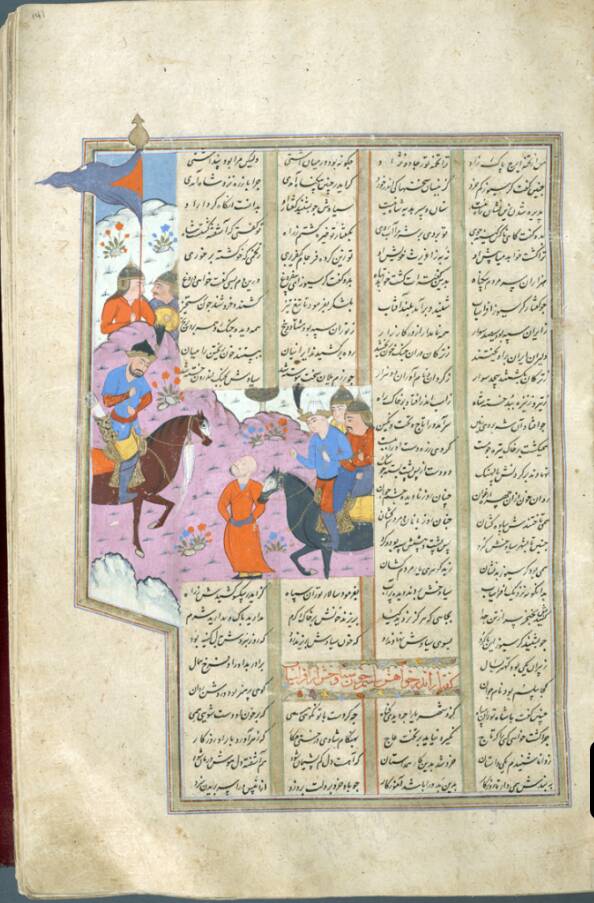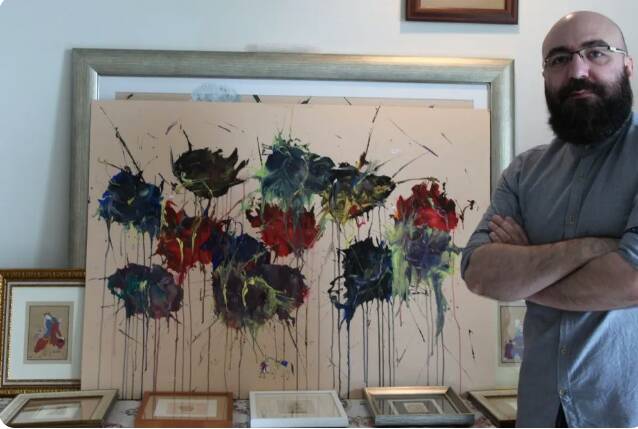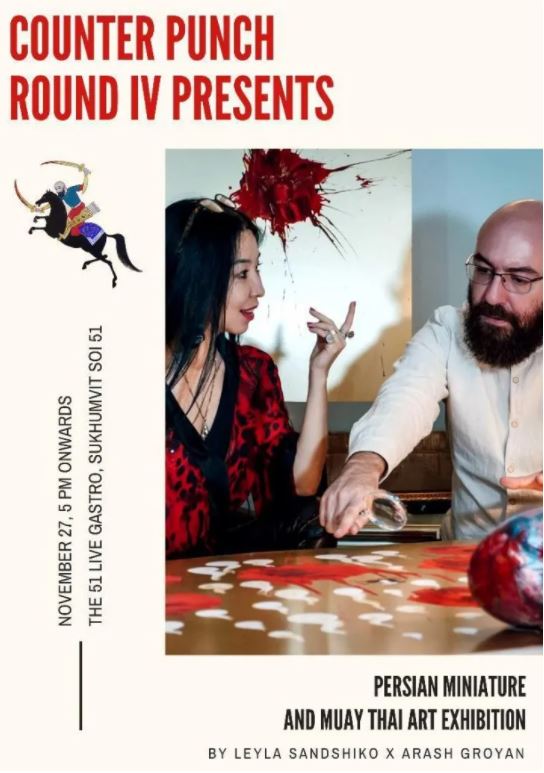Arash Groyan Brings Muay Thai to Persian Miniature Art
Arash Groyan Brings Muay Thai to Persian Miniature Art
วันที่นำเข้าข้อมูล 7 Dec 2021
วันที่ปรับปรุงข้อมูล 30 Nov 2022
Arash Groyan Brings Muay Thai to Persian Miniature Art
Most painters might use a brush or a palette knife to apply paint, keeping a wide range of shapes and sizes for precise control. But Arash Groyan’s latest work uses a different kind of tool.
Groyan works with Russian artist Leyla Sandshiko, who dips her Muay Thai gloves into paint and punches the canvas, leaving colors that burst energetically and drip in a messy, yet captivating way. However, amid the controlled chaos of these paint blossoms, you’ll find something unexpected: Groyan’s miniature figures, full of meticulous detail.


Wide shot and close-up of Arash Groyan’s “Musician” painting from Persian miniature & Muay Thai
Collection. Photo Credit: Tara Abhasakun
The 40-year-old artist first came to Thailand in 2009 as a tourist and fell in love with Thailand’s peaceful atmosphere, finding it conducive to his creative process. A few months later, he moved here, establishing himself among a diverse array of clients, including Americans, Europeans, and Thais.
Transitioning from Iranian to Thai culture was an exciting endeavor for Groyan. Iranian culture, he said, is more similar to European culture than Southeast Asian culture.
“In this country, the language, weather, and everything is very different. I loved this challenge.”

Persian miniature from the Shahnameh. Source: steve estvanik/Shutterstock.com
His usual art style is Persian miniature painting, a style likely originating in Persia during the Sassanian Empire in 3rd century CE. They mostly depict ancient Persian mythology and poetry—most importantly the Shahnameh, the Persian Book of Kings.
According to Groyan, miniature painters often use natural materials, such as gold mixed with honey, with brushes made from sable. Not unlike traditional Thai painting, there is no perspective or shadow in traditional Persian art.
An Iranian painter and jewelry designer, Groyan was inspired to create this collection after he saw Sandshiko’s art exhibition, in which she had splattered paint onto the canvas with her fists while wearing Muay Thai gloves. He began to wonder how it would look to combine this technique with Persian miniature painting, placing these characters in a different composition.

Wide shot and close-up of Arash Groyan’s “Effort” painting from Persian miniature & Muay Thai Collection. Photo Credit: Tara Abhasakun
Aside from the striking compositions of this collection, the sizes of Groyan’s paintings also differ from typical Persian miniature paintings. Usually, Persian miniatures can be 32 by 20 centimeters only, he said, but the paintings in this collection are 90 by 125 centimeters.
The dramatic colors are inspired by Groyan’s feelings of excitement and enthrallment while watching Muay Thai.
“Painting is similar to a kind of fight, and there is emotion. Each game for a fighter is a project, same as each painting is a project for me. For Muay Thai, each punch and blow to the opposite side is kind of [like] touching my brush to the surface of the canvas, cardboard, or paper.”

Groyan is not the first Persian to leave his mark on Thailand. In 1602, Persian merchant Sheikh Ahmad Qomi traveled to the cosmopolitan port city of Ayutthaya, eventually rising through the ranks to become a powerful trade official in the royal administration. Sheikh Ahmad’s descendents then married into the royal family, making him an ancestor of the Bunnag lineage.
It’s no surprise, then, that Persian culture has exerted an influence on traditional Thai art. Both Ayutthaya-era paintings in Thailand and Safavid-era miniature paintings in Persia incorporated the use of hills, trees, and buildings to separate the different scenes in their respective mythologies. In both styles, buildings are drawn with different dimensions folded out, including sides that in more realistic depictions would be invisible to viewers.
Groyan had the chance to see some of these parallels firsthand when he held a workshop with Thai artists at the Poh-Chang Academy of Arts, Rajamangala University of Technology Rattanakosin (🇹🇭), which was founded by King Rama VI to preserve and develop traditional Thai craftsmanship.
“Both of us did traditional art, and there were exact similarities between Thai traditional art and Iranian; I can tell you 80 percent similar.”
While much of Thailand’s fresco paintings found in temples, relate to the life of the Buddha and other Bhuddist mythology, Groyan said many paintings include designs inspired by the era of Sheikh Ahmad.
It’s interesting to think that other aspects of Thai culture, like Muay Thai, would go on to inspire a Persian miniature artist like Groyan, bringing the artistic influences full circle.

สถานเอกอัครราชทูต ณ กรุงเตหะราน
Office Hours: Sunday to Thursday, 08:30-12:00 and 13:00-16:30 (Except public holidays)